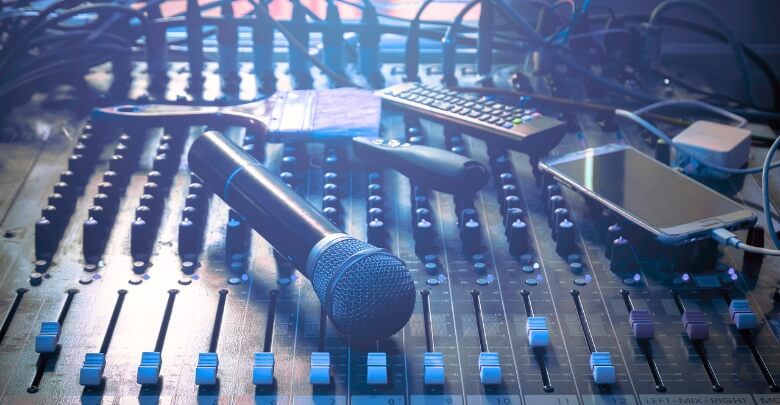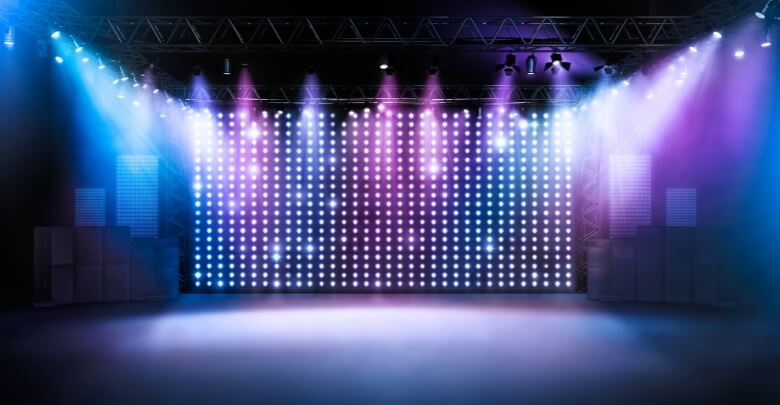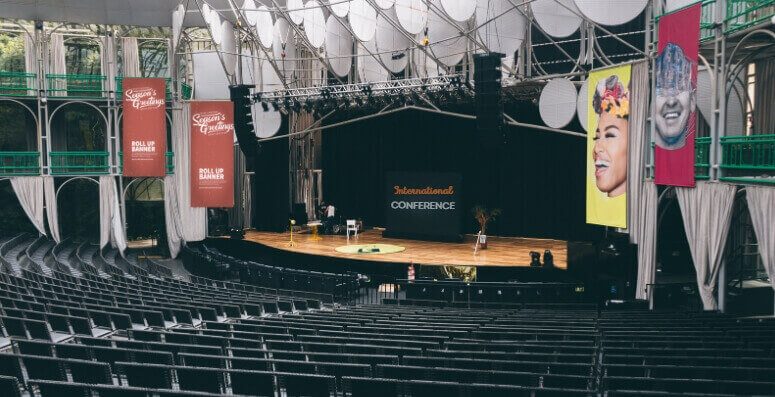As the famous adage goes, ‘Failing to plan is planning to fail.’ This statement is especially true when organizing a conference. One of the key aspects of any successful conference is ensuring that the right audio-visual equipment is in place. So, a question arises, “What AV equipment do I need for a conference?”
You should have the right AV equipment to ensure the conference runs smoothly. From audio systems to lighting and stage equipment, each element plays a crucial role in creating a memorable experience for attendees.
Choosing the right equipment can make all the difference in the success of your conference. This article will provide a comprehensive guide to help you choose the right AV equipment for your conference, considering factors such as your audio needs, visual equipment, budget, and venue.
What is AV equipment?
AV equipment, short for audiovisual equipment, includes all the tools and devices used to manage and enhance sound and visuals during events. Whether it’s a conference, presentation, or performance, this equipment helps ensure that everyone in the audience can see and hear everything clearly, no matter the size of the room. It’s the behind-the-scenes hero that makes communication effective and engaging.
When it comes to audio, AV equipment covers everything from microphones to speakers. Microphones capture the sound, whether it’s someone speaking or music playing, while speakers amplify it so the entire audience can hear. Mixers are often used to balance the sound levels, ensuring that everything is crystal clear and at the right volume, making sure no one misses a word.
On the visual side, AV equipment includes projectors and screens that display images, videos, or presentations. This equipment is essential for making sure everyone can follow along with what’s being presented, even in large spaces. Cameras might also be part of the setup, capturing live footage to be shown on big screens or streamed online, allowing the event to reach even more people.
Lighting is another key component of AV equipment. Good lighting highlights the speaker or performers, making them visible and keeping the audience’s attention where it needs to be. The right lighting also sets the mood and enhances the overall atmosphere of the event. Together, all these pieces of AV equipment work to create a seamless and immersive experience for everyone involved.
But before you move ahead, it’s better to know the essential AV equipment for conferences. Here’s a list of the top 10 AV equipment required in a conference.
- Microphones (handheld, lavalier, or headset)
- Speakers
- Audio Mixer
- Projector
- Screens
- Cameras (for recording/streaming)
- Stage Lighting
- Control Panel/System
- Cables and Connectors
- Internet Connection (Wi-Fi/Ethernet).
What AV Equipment Do I Need For a Conference?
When planning a conference, having the right AV (audiovisual) equipment is crucial to ensure that everything runs smoothly and that your presentations are effective and engaging. To have the right audio-visual equipment, you need to have a clear idea of what AV equipment do I need for a conference. Here’s a breakdown of the essential AV equipment you’ll need.
Determine Your Audio Needs
Assessing the required audio equipment for a conference is imperative, and determining the audio needs beforehand. One of the first considerations is the microphone option.
The type of microphone used will depend on the type of conference, the room size, and the number of speakers. For example, a lapel microphone is ideal for a conference where the speaker moves around on stage. In contrast, a handheld microphone may be more suitable for a panel discussion or Q&A session.
Another essential factor to consider is the sound system requirements. The type of sound system needed will vary depending on the size of the room and the number of attendees.
A small room may only require a basic PA system, while a larger conference room may require a more extensive sound system. Consider the sound system’s quality, as a poor sound system can negatively affect the overall experience of the conference.
Go through these above aspects and thus, selecting the right microphone for conferences will be easier for you. However, you should also ensure the conference room is soundproof properly. Otherwise, a good sound system will be worthless for your conference, which doesn’t meet attendees’ audio needs.
Select Your Visual Equipment
When considering the visual aspects of a conference, carefully select the appropriate technology to convey the desired message to the audience effectively. The choice between projection and display technology is an important one, as it can significantly impact the overall quality of the presentation.
Projection technology typically offers larger image sizes and can be more cost-effective, but it may have limitations regarding image quality and brightness. On the other hand, display technology, such as LED screens, can provide high-quality, bright images but may come at a higher cost.
Another essential consideration for visual equipment is whether the conference will be held indoors or outdoors. Outdoor conferences may require more robust equipment to withstand weather conditions like rain and wind.
Additionally, outdoor events may require more powerful projectors or displays to combat natural light and ensure the images or videos are visible to the audience. So, selecting the appropriate visual equipment is crucial in ensuring the conference succeeds and leaves a lasting impression on attendees.
Lighting and Stage Equipment
Effective use of lighting and stage equipment can greatly enhance conference attendees’ visual and auditory experience, creating a more immersive and engaging atmosphere.
Stage design is crucial to setting the tone and creating a memorable experience for attendees. The stage should be designed to complement the conference’s overall theme and highlight the speakers.
A well-designed stage can also make a big difference in camera shots for those watching remotely. Speaker preparation is also important when it comes to lighting and stage equipment.
Speakers should be well-lit to ensure they are visible to all attendees, and the lighting should be adjusted to their preferences. A good sound system is also critical for a conference, ensuring everyone can hear the speakers.
Technical Support and Setup
Technical support and setup are two essential components of any successful conference. Technical support ensures that all the equipment and technology are functioning correctly, while setup ensures everything is in its place and ready to use.
Remote assistance is an essential tool for technical support, especially in large conferences where issues may arise in different parts of the venue. With remote assistance, technical support staff can diagnose and troubleshoot issues remotely, saving time and money. Troubleshooting is also essential to technical support, as it helps identify and resolve any issues that may arise during the conference.
Backup equipment and redundancy are vital for ensuring that the conference runs smoothly. Backup equipment can be used in case of equipment failure, ensuring that the conference can continue without interruption.
Redundancy, on the other hand, refers to having multiple systems that can perform the same function. For example, having multiple microphones ensures that other microphones can be used if one fails. Having backup equipment and redundancy helps ensure the conference runs smoothly, despite technical issues.
Consider your budget and venue when planning for technical support and setup. Ensuring that you have the right technical support and setup can be costly, but it is essential for the success of your conference.
In that case, you can get funds for conferences by creating a compelling proposal highlighting the event’s benefits, targeting potential sponsors, exploring crowdfunding platforms, and considering applying for grants or seeking partnerships.
Your chosen venue can also affect the technical support and setup you need. For example, if the venue has a complicated sound or lighting system, you may need more technical support staff to ensure that everything runs smoothly.
Consider Your Budget and Venue
Careful consideration of the financial resources and venue specifications is a crucial step for conference hosts when planning technical support and setup for a conference. The size of the venue and the rental options available can significantly impact the AV equipment required. Ensure that the equipment is appropriate for the size of the venue and the number of attendees.
When determining the AV requirements for conference, consider rental options. Many companies offer AV equipment rental services that can be tailored to the specific needs of the conference. This is often more cost-effective than purchasing equipment outright, especially if the equipment is only needed for a short period.
Additionally, rental companies can provide technical support, ensuring the equipment is set up correctly and functions throughout the conference. By carefully considering the budget and venue specifications, organizers can ensure that the conference has the necessary AV equipment to meet its needs without overspending.
| Venue Size | Recommended Equipment | Rental Cost |
| Small (up to 50 people) | Projector, screen, sound system | $150-$250 |
| Medium (50-200 people) | Large projector or LED wall, sound system, wireless microphones | $500-$1500 |
| Large (200+ people) | Multiple projectors or LED walls, advanced sound system, stage lighting, video recording equipment | $2500+ |
The table above roughly estimates the recommended equipment and rental costs for a conference based on venue size. Note that these are just guidelines and that the specific needs of each conference may vary.
By carefully considering the venue size and rental options available, organizers can ensure they are equipped with the necessary AV equipment to make their conference successful.
Why is AV Equipment Essential for a Conference?
AV equipment is essential for a conference because it plays a vital role in ensuring that the event runs smoothly and effectively. Here’s why it’s so important.
Clear Communication
At the heart of any conference is the need to communicate ideas, share knowledge, and engage with the audience. AV equipment, like microphones and speakers, ensures that everyone can hear the speakers clearly, no matter where they are sitting. It eliminates the struggle of straining to hear or missing key points, making sure that the message is delivered loud and clear.
Visual Impact
Visual elements are just as important as audio. Projectors, screens, and monitors help to display presentations, videos, and other visual content in a way that’s easily accessible to everyone in the room. This not only supports the speaker’s message but also makes the information more engaging and easier to understand. Good visuals can turn a standard presentation into something memorable.
Audience Engagement
Conferences are more than just lectures—they’re about interaction and engagement. AV equipment allows for this by enabling live polls, Q&A sessions, and other interactive elements that make the audience feel involved. When attendees can participate and contribute, they’re more likely to stay interested and engaged throughout the event.
Professionalism
The right AV setup conveys professionalism. High-quality sound, clear visuals, and seamless transitions between different parts of the event reflect well on the organizers and speakers. It shows that the event is well-prepared, which helps build credibility and trust with the audience.
Adaptability and Flexibility
Conferences often involve multiple speakers, panel discussions, and even remote participants. AV equipment allows you to seamlessly switch between different formats, whether it’s a live presentation, a video call with a remote speaker, or a pre-recorded video. This flexibility ensures that the conference can adapt to different needs and keep things running smoothly.
All in all, AV equipment is the backbone of a successful conference. It ensures that ideas are communicated effectively, the audience is engaged, and the event looks and sounds professional. Without it, even the best content can fall flat.
Poor AV Equipment and Its Disadvantages
Having poor audio-visual (AV) equipment at a conference can really derail the entire experience, both for the organizers and the attendees. Here are the reasons.
Communication Breakdowns
Imagine sitting in the audience, straining to hear what the speaker is saying because the microphone keeps cutting out, or the sound is too low. When the audio isn’t clear, the message gets lost. Attendees miss important information, leading to confusion and frustration. Poor audio can make even the most compelling speaker seem ineffective.
Unprofessional Appearance
Flickering projectors, blurry screens, or bad lighting can make a conference feel amateurish. When the visuals don’t match the quality of the content, it reflects poorly on the event and the organizers. It can make the whole experience feel less polished and less credible, affecting how seriously attendees take the presentations.
Decreased Engagement
Good AV equipment helps keep the audience engaged. But if the visuals are hard to see or the sound is distorted, people will quickly lose interest. They might start checking their phones or mentally checking out. Once the audience disengages, it’s tough to get them back.
Technical Glitches and Delays
Poor AV equipment often leads to technical issues, like feedback from microphones, frozen video streams, or dropped connections during a live feed. These glitches cause delays, disrupt the flow of the conference, and can make it hard to maintain the schedule. The more interruptions there are, the more frustrated everyone becomes.
Lost Opportunities
When AV equipment doesn’t work properly, you lose the chance to make a strong impression. Whether it’s a keynote speech, an important presentation, or a live demonstration, poor AV can turn what should have been a highlight into a missed opportunity. This can impact the overall success of the event and the satisfaction of the attendees.
In short, poor AV equipment can take a well-planned conference and turn it into a frustrating experience for everyone involved. Investing in good AV is crucial to ensuring that your event runs smoothly and leaves a positive impression.
Frequently Asked Questions
What are the most common AV setup mistakes to avoid?
Avoid these common AV setup mistakes: neglecting proper lighting, skipping audio checks, overlooking equipment compatibility, and forgetting backup options. Planning ahead and testing everything can save you from technical hiccups and ensure a smooth experience for everyone.
What type of projector is best for a large conference?
For a large conference, a high-lumen laser projector is ideal. It offers bright, clear images even in well-lit rooms and provides better color accuracy and reliability. Choose one with a good resolution to keep your audience engaged and focused.
Do I need a sound system for a small conference?
Yes, a sound system is essential for a small conference. Even in smaller spaces, clear audio helps everyone hear the speakers comfortably. It enhances engagement and ensures that important messages are effectively communicated, making your event more enjoyable.
Is it necessary to hire a technician for AV equipment at a conference?
Hiring a technician for AV equipment can be a smart move. They ensure everything runs smoothly, troubleshoot issues quickly, and let you focus on your conference instead of worrying about tech problems. Peace of mind is worth it.
How do I plan the AV layout for my conference venue?
Start by assessing the venue’s size and shape, then position screens and speakers for optimal visibility and sound. Consider audience flow and accessibility, and always test the setup beforehand. A well-planned layout creates a better experience for everyone.
Final Words
Hosting a successful conference requires careful planning and preparation. Knowing “What AV equipment do I need for a conference” is also part of the planning. The selection of AV equipment ensures the event runs smoothly and engages the audience. From determining audio needs to selecting visual equipment and lighting, every detail should be considered.
One interesting statistic highlighting the importance of AV equipment in conferences is that 93% of event professionals believe technology can enhance the attendee experience. This underscores the need to invest in high-quality AV equipment to create an engaging and immersive experience for attendees.
By taking the time to consider your budget, venue, and technical support needs, you can ensure that your conference is a success and leaves a lasting impression on attendees.








